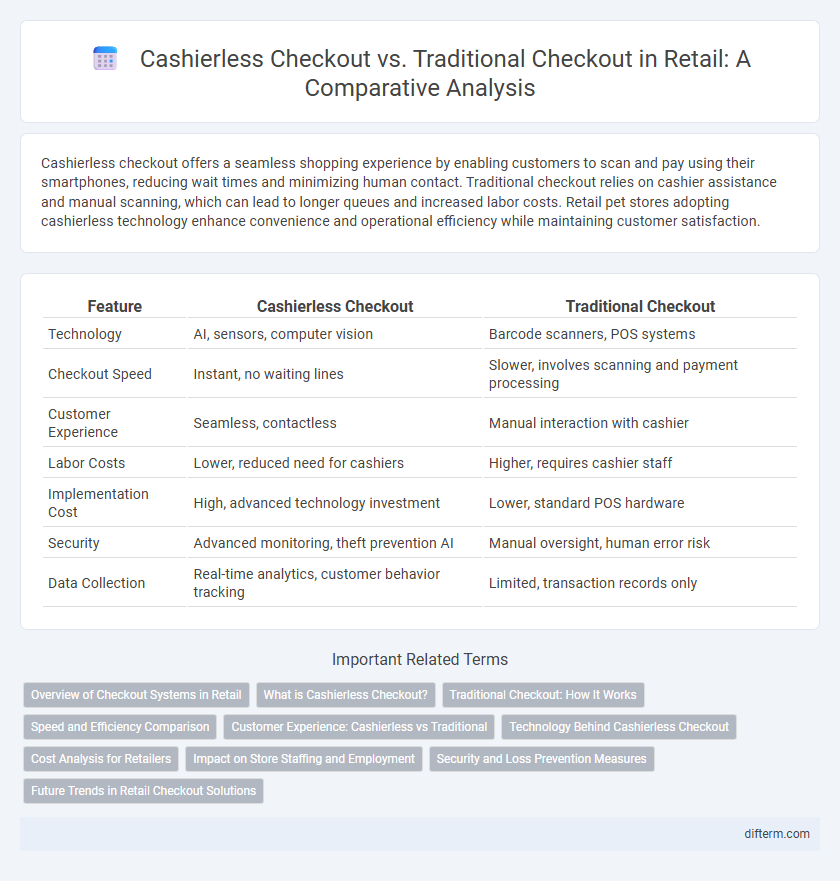Cashierless checkout offers a seamless shopping experience by enabling customers to scan and pay using their smartphones, reducing wait times and minimizing human contact. Traditional checkout relies on cashier assistance and manual scanning, which can lead to longer queues and increased labor costs. Retail pet stores adopting cashierless technology enhance convenience and operational efficiency while maintaining customer satisfaction.
Table of Comparison
| Feature | Cashierless Checkout | Traditional Checkout |
|---|---|---|
| Technology | AI, sensors, computer vision | Barcode scanners, POS systems |
| Checkout Speed | Instant, no waiting lines | Slower, involves scanning and payment processing |
| Customer Experience | Seamless, contactless | Manual interaction with cashier |
| Labor Costs | Lower, reduced need for cashiers | Higher, requires cashier staff |
| Implementation Cost | High, advanced technology investment | Lower, standard POS hardware |
| Security | Advanced monitoring, theft prevention AI | Manual oversight, human error risk |
| Data Collection | Real-time analytics, customer behavior tracking | Limited, transaction records only |
Overview of Checkout Systems in Retail
Cashierless checkout systems leverage advanced technologies such as computer vision, sensor fusion, and artificial intelligence to enable seamless, automated payment processes without the need for cashiers, enhancing customer convenience and reducing labor costs. Traditional checkout systems rely on manual scanning of products by cashiers or self-service kiosks, which can lead to longer wait times and increased operational expenses. The shift towards cashierless technology reflects a broader trend in retail to improve efficiency, minimize friction at point of sale, and provide real-time inventory tracking.
What is Cashierless Checkout?
Cashierless checkout is an innovative retail technology that allows customers to purchase products without interacting with a cashier or waiting in line. Utilizing sensors, cameras, and artificial intelligence, it tracks items taken by shoppers and automatically charges their account as they exit the store. This system enhances convenience, reduces labor costs, and improves store efficiency compared to traditional checkout methods.
Traditional Checkout: How It Works
Traditional checkout involves a cashier scanning each item's barcode manually, which can lead to longer wait times during peak hours. Payment is processed via cash, card, or mobile payment methods, requiring customer interaction with the cashier or payment terminal. Inventory systems update in real-time only after the transaction is completed, which can delay stock management accuracy.
Speed and Efficiency Comparison
Cashierless checkout systems significantly reduce transaction times by enabling customers to scan and pay using mobile apps or sensors, eliminating the need for manual scanning and cash handling. Traditional checkout lanes often experience bottlenecks during peak hours due to cashier availability and payment processing delays. Retailers implementing cashierless technology can achieve higher throughput and improved customer satisfaction by streamlining the purchasing process and minimizing wait times.
Customer Experience: Cashierless vs Traditional
Cashierless checkout enhances customer experience by reducing wait times and streamlining payment through automated sensors and mobile app integration, allowing shoppers to leave without stopping at a register. Traditional checkout provides personalized interaction with cashiers, which some customers prefer for assistance and human connection. Retailers adopting cashierless technology must balance speed and convenience with customer support to optimize satisfaction.
Technology Behind Cashierless Checkout
The technology behind cashierless checkout leverages computer vision, sensor fusion, and machine learning algorithms to track customers and products in real-time, enabling seamless, cashier-free transactions. Advanced cameras and weight sensors on shelves detect item selection and automatically update the shopping cart, while mobile apps or RFID technology facilitate payment without manual scanning. This integration reduces wait times and enhances customer experience compared to traditional checkout systems that rely on barcode scanning and cashier intervention.
Cost Analysis for Retailers
Cashierless checkout systems reduce labor expenses by minimizing the need for cashiers, resulting in significant cost savings for retailers. Although initial investments in technology, such as sensors, AI, and IoT infrastructure, are substantial, the long-term operational expenses decrease due to automated inventory management and faster transaction times. Traditional checkout requires ongoing labor costs and can experience bottlenecks during peak hours, impacting overall efficiency and profitability.
Impact on Store Staffing and Employment
Cashierless checkout technology significantly reduces the need for traditional cashier roles, shifting store staffing requirements toward technical maintenance and customer assistance positions. While this automation can decrease labor costs and improve efficiency, it also raises concerns about job displacement for frontline retail workers. Retailers must balance implementing innovative checkout solutions with workforce retraining and redeployment strategies to mitigate unemployment risks.
Security and Loss Prevention Measures
Cashierless checkout systems leverage advanced technologies such as computer vision, sensor fusion, and AI algorithms to enhance security by reducing human error and minimizing opportunities for theft, enabling real-time monitoring and anomaly detection. Traditional checkout methods rely on manual oversight and physical cashier interactions, which can introduce vulnerabilities like cashier scams or human error in transaction processing. Implementing cashierless technology combined with robust encryption and data analytics significantly strengthens loss prevention strategies by automating inventory tracking and identifying suspicious consumer behavior patterns.
Future Trends in Retail Checkout Solutions
Cashierless checkout technology leverages AI, computer vision, and sensor fusion to enable seamless, frictionless shopping experiences by eliminating the need for manual scanning and payment processes. Future trends indicate widespread adoption of autonomous checkout systems integrated with mobile payment platforms and personalized customer data analytics to enhance speed and convenience. These advancements aim to reduce labor costs and improve store efficiency, reshaping the retail landscape by prioritizing contactless, real-time transaction solutions.
cashierless checkout vs traditional checkout Infographic

 difterm.com
difterm.com